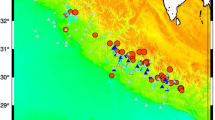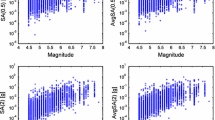Abstract
Several empirical models for the prediction of ground motion duration were developed across the world, but no model has been generated for the Himalayan region in the past. In this study, an attempt is made to study the duration models developed for different regions and compare them with a reference model developed for the Himalayan region for a wide range of magnitudes. The comparison is performed using the log-likelihood method and aims to identify the best duration prediction models based on the developed by Bajaj and Anbazhagan (2019) for the study region. The data support index values along with the weights of the corresponding models across the different distances and magnitude ranges have also been estimated. The study found that the predictive duration relation given by Lee and Green (2014) for Western North America is suitable for M ≤ 5, while the model developed by Ghanat (2011) is suitable for M > 5 for the Himalayan region. The model developed by Afshari and Stewart (2016) is also very close to the reference model. It is always preferable to have a single duration predictive model for a wide range of magnitude and distance range; hence, there is a need to develop a region-specific duration predictive model for the Himalayan region.








Similar content being viewed by others
References
Abrahamson N A and Silva W J 1996 Empirical ground motion models; Technical report 1996 Brookhaven National Laboratory.
Afshari K and Stewart J 2016 Physically parameterized prediction equations for significant duration in active crustal regions; Earthq. Spectra 32, https://doi.org/10.1193/063015EQS106M.
Anbazhagan P, Sreenivas M, Ketan B and Sayed Sr Moustafa 2016 Selection of ground motion prediction equations for seismic hazard analysis of peninsular India; J. Earthq. Eng. 20 699–737.
Anbazhagan P, Neaz Sheikh M, Bajaj K, Mariya Dayana P J, Madhura H and Reddy G R 2017 Empirical models for the prediction of ground motion duration for intraplate earthquakes; J. Seismol. 21 1001–1021, https://doi.org/10.1007/s10950-017-9648-2.
Anbazhagan P, Joo M R, Rashid M M and Al-Arifi N S N 2021 Prediction of different depth amplifications of deep soil sites for potential scenario earthquakes; Nat. Hazards, pp. 1–29.
Arias A 1970 Measure of earthquake intensity; In: Seismic design for nuclear power plants (ed.) Hansen R J, MIT Press, Cambridge, Massachusetts, pp. 438–483.
Auden J B and Ghosh A M N 1934 Preliminary account of the earthquake of the 15th January, 1934, in Bihar and Nepal; Rec. Geol. Surv. India 68 177–293.
Bajaj K and Anbazhagan P 2019 Regional stochastic GMPE with available recorded data for active region – Application to the Himalayan region; Soil Dyn. Earthq. Eng. 126 105825.
Bommer J J and Martínez-Pereira A 1999 The effective duration of earthquake strong motion; J. Earthq. Eng. 3 127–172, https://doi.org/10.1080/13632469909350343.
Bommer J J, Hancock J and Alarcón J E 2006 Correlations between duration and number of effective cycles of earthquake ground motion; Soil Dyn. Earthq. Eng. 26 1–13.
Bommer J J, Stafford P J and Alarcón J E 2009 Empirical equations for the prediction of the significant, bracketed, and uniform duration of earthquake ground motion; Bull. Seismol. Soc. Am. 99 3217–3233.
Boore D and Thompson E 2014 Path durations for use in the stochastic-method simulation of ground motions; Bull. Seismol. Soc. Am. 104, https://doi.org/10.1785/0120140058.
Delavaud E, Scherbaum F, Kuehn N and Allen T 2012 Testing the global applicability of ground-motion prediction equations for active shallow crustal regions; Bull. Seismol. Soc. Am. 102 707–721, https://doi.org/10.1785/0120110113.
Dobry R, Idriss I M and Ng E 1978 Duration characteristics of horizontal components of strong-motion earthquake records; Bull. Seismol. Soc. Am. 68 1487–1520.
Douglas J 1964–2020 Ground motion prediction equations; Pacific Earthquake Engineering Research Center, Berkeley, CA.
Ghanat S 2011 Duration characteristics of the mean horizontal component of shallow crustal earthquake records in active tectonic regions; Ph.D. Thesis, Arizona State University.
Hernandez B and Cotton F 2000 Empirical determination of the ground shaking duration due to an earthquake using strong motion accelerograms for engineering applications; In: Proceedings of Twelfth World Conference on Earthquake Engineering.
Huang C, Tarbali K and Galasso C 2020 Correlation properties of integral ground-motion intensity measures from Italian strong-motion records; Earthq. Eng. Struct. Dyn. 49 1581–1598.
Kamiyama M 1984 Effects of subsoil conditions and other factors on the duration of earthquake ground shakings; In: Eighth World Conference on Earthquake Engineering, Volume II, pp. 793–800.
Kempton J J and Stewart J P 2006 Prediction equations for significant duration of earthquake ground motions considering site and near-source effects; Earthq. Spectra 22 985–1013.
Khattri K N 1987 Great earthquakes, seismicity gaps and potential for earthquake disaster along the Himalaya plate boundary; Tectonophysics 138 79–92.
Lee J and Green R 2014 An empirical significant duration relationship for stable continental regions; Bull. Earthq. Eng. 12, https://doi.org/10.1007/s10518-013-9570-0.
Podili B and Raghukanth S T G 2019 Ground motion prediction equations for higher order parameters; Soil Dyn. Earthq. Eng. 118 98–110, https://doi.org/10.1016/j.soildyn.2018.11.027.
Pousse G, Bonilla L F, Cotton F and Margerin L 2006 Nonstationary stochastic simulation of strong ground motion time histories including natural variability: Application to the K-net Japanese database; Bull. Seismol. Soc. Am. 96 2103–2117, https://doi.org/10.1785/0120050134.
Ramkrishnan R, Sreevalsa K and Sitharam T G 2019 Development of new ground motion prediction equation for the North and Central Himalayas using recorded strong motion data; J. Earthq. Eng. 1–24.
Salmon M W, Short S A and Kennedy R P 1992 Strong motion duration and earthquake magnitude relationships; United States, https://doi.org/10.2172/67453.
Sandikkaya M A and Akkar S 2016 Cumulative absolute velocity, Arias intensity and significant duration predictive models from a pan-European strong-motion dataset; Bull. Earthq. Eng., pp. 1–18, https://doi.org/10.1007/s10518-016-0066-6.
Scherbaum F, Delavaud E and Riggelsen C 2009 Model selection in seismic hazard analysis: An information-theoretic perspective; Bull. Seismol. Soc. Am. 99 3234–3247.
Sharma M L, Douglas J, Bungum H and Kotadia J 2009 Ground-motion prediction equations based on data from the Himalayan and Zagros regions; J. Earthq. Eng. 13 1191–1210.
Snæbjörnsson J and Sigbjornsson R 2008 The duration characteristics of earthquake ground motions; In: Proceedings of Fourteenth World Conference on Earthquake Engineering.
Trifunac M D and Brady A G 1975 A study on the duration of strong earthquake ground motion; Bull. Seismol. Soc. Am. 65 581–626.
Xie J, Wen Z and Li X 2012 Characteristics of strong motion duration from the Wenchuan Mw 7.9 earthquake; In: Proceedings of the 15th World Conference on Earthquake Engineering, Lisbon, Portugal.
Yaghmaei-Sabegh S, Shoghian Z and Sheikh M N 2014 A new model for the prediction of earthquake ground-motion duration in Iran; Nat. Hazards 70 69–92.
Acknowledgements
The authors thank the Dam Safety (Rehabilitation) Directorate, Central Water Commission for funding the project entitled ‘Capacity Buildings in Dam Safety’ under ‘Dam Rehabilitation and Improvement Project’. The authors would also like to thank the M/s Secon for funding the project ‘Effect of shear wave velocity calibration on amplification of shallow and deep soil sites’ Ref.: SECON/IISc/MoES/WO/07-18/0079, date: 14/8/2018.
Author information
Authors and Affiliations
Contributions
P Anbazhagan contributed to the methodology, conceptualization, envisioning the guided work and drafting of the manuscript. Kunal Motwani contributed to data collection, performing the analysis and drafting of the manuscript.
Corresponding author
Additional information
Communicated by Anand Joshi
Rights and permissions
About this article
Cite this article
Anbazhagan, P., Motwani, K. Ground motion duration predictive models applicable for the Himalayan region. J Earth Syst Sci 132, 112 (2023). https://doi.org/10.1007/s12040-023-02120-2
Received:
Revised:
Accepted:
Published:
DOI: https://doi.org/10.1007/s12040-023-02120-2




